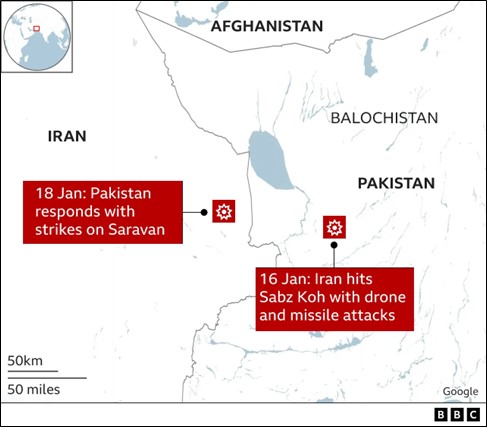Academy SITREP – Iran and Pakistan Exchange Strikes

What has Happened:
- Earlier today, Pakistan conducted strikes inside Iran against separatist hideouts, a day or so after Iranian forces launched an attack on what they claimed were militant camps in Pakistan.
- Pakistan attacked at least seven locations used by separatists from the Baloch ethnic group about 30 miles inside of the border with air force fighters and drones, while Iran used “precision missile and drone strikes” to strike the Sunni militant group Jaish al-Adl in Pakistan’s southwest Balochistan province.
- Earlier this week, Iran’s IRGC launched ballistic missiles at what it claimed was a spy base for Israel’s intelligence agency (Mossad) in northern Iraq, and at “anti-Iran terror groups” in Syria.
- Iran’s strikes in Iraq, Syria, and now Pakistan were driven by growing domestic pressure to act against militants, especially after the ISIS bombing in Iran earlier this month that killed over 80 people.
- While Iran used these attacks to demonstrate its ability to strike outside of its territory (and “flex its muscles”) with longer-range precision guided weapons, Pakistan was forced to respond to send a message right back to Iran.
- However, neither Iran nor Pakistan have the incentive to see this situation escalate and both sides indicated that their strikes were not intended to kill nationals on either side.
- Meanwhile, the U.S. continues to conduct strikes against Iran-backed Houthi militants (5 times in the past week) and has re-designated the Houthis as a terrorist organization.
Why it Matters:
“The U.S. is attempting to deescalate and contain the conflict to Hamas in Gaza, while Iran and its proxies want to escalate and widen the conflict regionally to increase international and U.S. pressure on Israel to agree to a ceasefire. So far Iran is winning. The Iranian-backed militia attacks in Iraq drew the U.S. into a retaliatory strike on a Shia militia leader in Baghdad (upsetting the Iraqi government) and resulted in it discussing a plan for U.S. military forces to leave Iraq. The continued Red Sea attacks by the Houthis forced the U.S. to increase the scale of its response. For now, it’s expected that the U.S. will continue to limit its retaliatory strikes and not conduct an integrated campaign to eliminate the Houthi’s shipping attack capabilities. Iran’s attack in Pakistan and Pakistan’s retaliatory response have widened the conflict regionally. The situation has crossed the line into a regional conflict that the U.S. was determined to avoid but has little ability to control at this point. Iran is increasingly leveraging the conflict in Gaza to challenge and diminish U.S. influence in the Middle East through its proxy force operations.” – General Robert Walsh
“Iran is asserting itself for three reasons: to demonstrate that it can do so without consequence, to advantage and further the global condemnation of Israel, and to challenge and dilute U.S. influence. This is a lengthy conflict now escalating in the Middle East and the pace and scope of operations are picking up. It’s not expansionist yet and will not be unless Iran is confronted directly by the U.S., the U.K., or Israel. Iran understands and will respond to force.” – General Spider Marks
“Iran is just seizing the moment to flex its muscle. We are striking their proxies, and they are publicly using that as permission to do the same. Just stirring the pot on the international level to make a point.” – General Mastin Robeson
“The Iranians feel that they can strike where they want because others (Israel and the U.S.) are doing so. This allows them freedom of action beyond just proxies.” – General Frank Kearney


